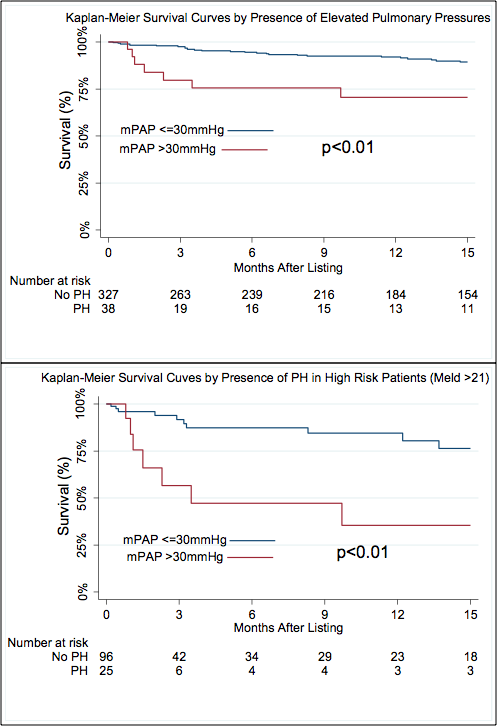WHO Group II Pulmonary Hypertension Is Associated with Decreased Survival in Patients Awaiting Liver Transplantation.
Medicine, Houston Methodist Hospital, Houston, TX
Meeting: 2017 American Transplant Congress
Abstract number: C196
Keywords: Liver transplantation, Pulmonary hypertension, Survival, Waiting lists
Session Information
Session Name: Poster Session C: Organ Allocation, Meld Score, Organ Utilization, and Transplant Outcomes
Session Type: Poster Session
Date: Monday, May 1, 2017
Session Time: 6:00pm-7:00pm
 Presentation Time: 6:00pm-7:00pm
Presentation Time: 6:00pm-7:00pm
Location: Hall D1
End stage liver disease (ESLD) patients with cirrhotic cardiomyopathy often have WHO Group II pulmonary hypertension (PH), characterized by pulmonary capillary wedge pressure (PCWP) >15 mm Hg and mean pulmonary artery pressure (mPAP) >25 mm Hg. Though effect of porto-pulmonary PH (WHO Group I) on survival of ESLD patients is well known, impact of WHO Group II PH in these patients is unknown. We analyze impact of WHO Group II PH on survival of ESLD patients awaiting liver transplantation.
Methods: We performed retrospective analysis of ESLD patients who had right heart catheterization for liver transplant candidacy evaluation from 2012-2015. Kaplan-Meier curves were plotted to analyze the impact of PCWP>15 mm Hg and elevated mean pulmonary artery pressure (mPAP> 30 mm Hg) on 1-year waitlist survival. To study impact of these parameters in highest risk patients, the population was divided using calculated Model for End-Stage Liver Disease (MELD) score at listing and those with MELD > 21 were considered high risk (cutoff for the highest tertile).
Results: 365 patients were waitlisted for liver transplant during study period. Patients with mPAP > 30 mm Hg had deceased 1-year waitlist survival compared to those with mPAP ≤ 30 mm Hg (70±9% vs 92 ±1%, p<0.01). In a subgroup of patients with PCWP > 15 mm Hg, those who had mPAP > 30 mm Hg (WHO Group II PH patients), had decreased waitlist survival (69±9% vs 88±5, p=0.04). These parameters had a greater impact in high risk patients i.e. MELD ≥ 21. These patients had a 75% 1-year waitlist survival and when dichotomized by high PCWP, their survival fell to 52% vs 86% for PCWP ≤15 mm Hg, p=0.04. Of note, when these high risk patients were dichotomized by mPAP > 30 mm Hg, survival was only 35% vs 76% for mPAP ≤ 30 mm Hg, p<0.01.
Conclusion: WHO group II PH (PCWP > 15 and mPAP > 30 mm Hg) is associated with significant increase in waitlist mortality. This survival disadvantage is greater in patients with higher MELD and hence earlier transplantation in this patient population might be warranted. 
CITATION INFORMATION: Memon H, Guerra J.-A, Trachtenberg B, Estep J, Bhimaraj A, Hussain I, Park M, Monsour H, Ghobrial M, Guha A. WHO Group II Pulmonary Hypertension Is Associated with Decreased Survival in Patients Awaiting Liver Transplantation. Am J Transplant. 2017;17 (suppl 3).
To cite this abstract in AMA style:
Memon H, Guerra J-A, Trachtenberg B, Estep J, Bhimaraj A, Hussain I, Park M, Monsour H, Ghobrial M, Guha A. WHO Group II Pulmonary Hypertension Is Associated with Decreased Survival in Patients Awaiting Liver Transplantation. [abstract]. Am J Transplant. 2017; 17 (suppl 3). https://atcmeetingabstracts.com/abstract/who-group-ii-pulmonary-hypertension-is-associated-with-decreased-survival-in-patients-awaiting-liver-transplantation/. Accessed December 24, 2025.« Back to 2017 American Transplant Congress
